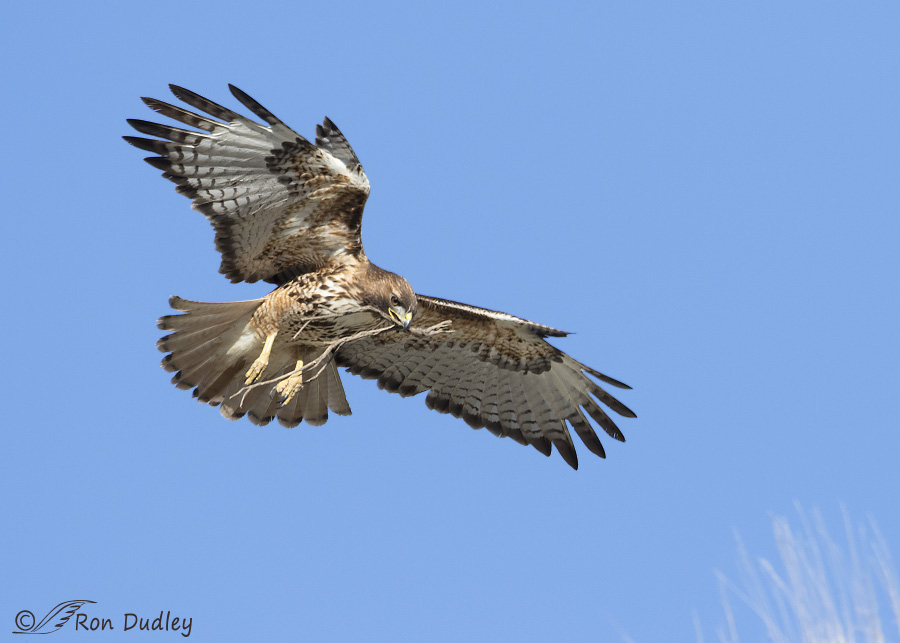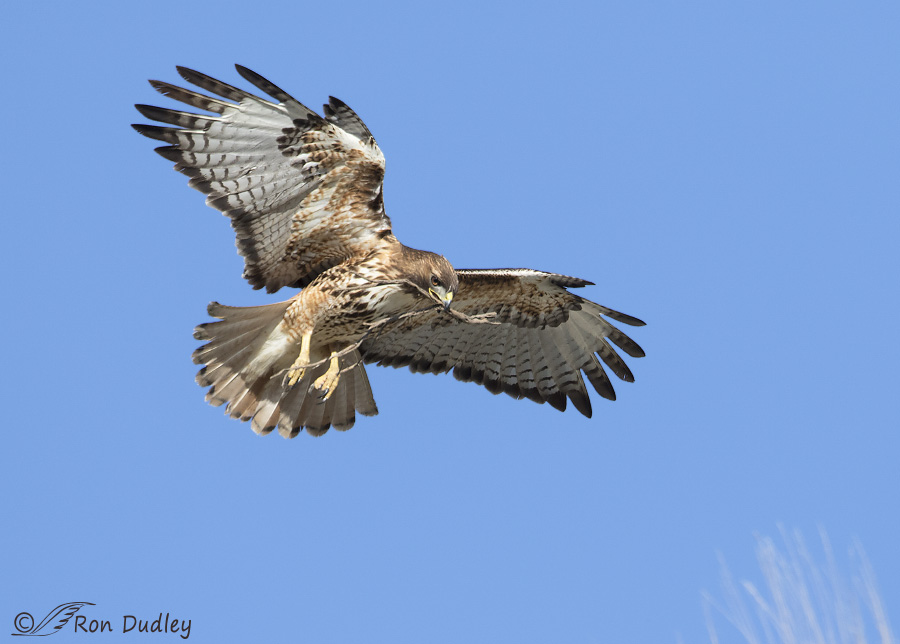I seldom photograph raptors with nesting material because I won’t closely approach their nests.

1/1600, f/7.1, ISO 400, Canon 7D Mark II, Canon EF 500mm f/4L IS II USM + 1.4 tc, not baited, set up or called in
But I got lucky with this female Red-tailed Hawk a month ago in Box Elder County. She would fly in with nesting material in her talons and land next to her mate who was perched on the top of a high cliff. After resting there next to the male for a short period she would transfer the stick to her beak and then take off for the rest of the journey to the nest. Here she’s kiting in the updrafts off the cliff just after takeoff.
I posted a similar image of her a few weeks ago but in that shot the underside of her right wing was shaded and there’s nothing but blue sky in the background. Here there’s some light under that wing and there are grasses growing on the top of the cliff in the lower right corner. To me those grasses are a positive addition to the image because they help to ground the hawk and give some context to the image. But opinions on that grass may vary…

1/1250, f/7.1, ISO 400, Canon 7D Mark II, Canon EF 500mm f/4L IS II USM + 1.4 tc, not baited, set up or called in
And though this image is very similar to the previous one there are some subtle differences in light under both the right wing and the tail.
I prefer good light on the ventral surfaces of birds flying above me which is one of the reasons I typically photograph them in the early morning with the sun low in the sky. There are other reasons including:
- birds tend to be most active in the morning after a long night of hunkering in cover without food
- light is significantly warmer and less harsh when the sun is low in the sky than it is at midday
- when the sun is high in the sky it’s much more difficult to get a catch light in the eye, particularly in raptors with their heavy brow ridges
- in my experience most birders and many bird photographers are much more fond of their sleep than they are of being out and about soon after dawn. And that’s just dandy with me because it means there’s far fewer vehicles on the roads, usually gravel or dirt, to flush “my” birds (I nearly always shoot from my pickup)
- I’m a morning person by nature. IMO that’s the very best time of day to be alive, hands down!
Ron


I agree with you about the mornings – when the world feels reborn, before the thoughts and acts of humans have begun polluting the atmosphere.
Oh, as for the human element, let’s not go there. I’ve had enough stress this weekend what with crazy drivers on the road and a Kestrel tangled at the top of a tall (she’s safe now–and no that was NOT the plan!). All we can do is TRY to install ethics through education, but sometimes I think there’s far more than education can solve.
What a gorgeous shot…as usual. I’ve been away for the weekend, and the computer didn’t want to work there, so I’m just now catching up.
I’d echo what everybody else said, but I’m also wondering if this bird isn’t a young one, in her first nesting attempt? I can’t tell for sure given the lighting, but her eyes look to be that lovely sandy brown? With her red tail, she’d be at least in her third year. Their eyes darken with age and at differing rates–sometimes they’ll darken in their juvenile year and sometimes not for several years. Mariah’s didn’t darken totally until she was six or seven years old. I should have taken notes of when that happen, but I didn’t. Sigh…
Add me to the morning person category. I like the quiet, and love the beauty as day unfolds.
Thank you – both for the image(s) and for your ethics.
I frequently dispair of our race, and am (nearly as frequently) reminded not to tar everyone with my brush of disdain.
You’re right, EC – there are a lot of good folks out there. But dammitall, they do seem to be a rarer commodity than they used to be…
I enjoy ALL of your perfect photos AND the newsy info on them.
Well, there aren’t many perfect ones, Linda, but I work at getting some as close to that as possible. Thank you.
OMG, Ron!! She is a beautiful Red-tailed Hawk and you have shown her off magnificently!! I keep saying that the wildlife you photograph know how good you are and want their portrait taken by the best!! I have to also say how much I respect your ethics that you practice in taking your photos of wildlife. I’m seeing more and more postings on Facebook of both professional photographers and the general public doing whatever it takes to get their photos – totally oblivious to how they are being absolutely uncaring about the stress and danger they are putting the poor animals in. One post must have had 20 prof. photographers all pressed together with their tripods/camera equipment trying to photographer one poor Sandhill Crane that was so scared and was so hemmed in it couldn’t spread it’s wings to escape. It made me so sick – another example of how badly some humans think they are “entitled’ to do whatever “they” want and God help their victims. Now back on a happy note, thanks for one more wonderful wildlife series!
Jo Ann, Some of the tactics used by birders and photographers in the field are absolutely sickening, though I’d have to admit that photographers on average seem to be worse offenders than birders. However that equation is changing as more and more birders invest in DSLR cameras and high quality telephoto lenses.
For many getting “the shot” is priority number one and the welfare of their subjects be damned. And many are incredibly innovative in their devious techniques.
And those deplorable tactics, by professional and amateur photographers alike, are FAR more pervasive than most people think…
That type of behavior seems increasingly prevalent…ex. All those who swoop in to take photos of accidents and disasters (in the hope of selling their pictutes?) rather than rushing to aid the victims…sickening!!!
OMG, Patty – I wasn’t aware tTHAT was happening??!!! That is more than sick!!!
Ron, I think there is hope with birders whose hobby starts with a love of the birds. Not all Prof. Photographers are wildlife lovers. There needs to be lots of education for the new birders. I’ve learned a lot from you in this area. Also The Birds of America, Cornell Lab and Audubon, etc. need to help with educating birders. I also think that the live cams would be a great spot for educating the newbies. I would hope the newbies who fall in love with the animals they are viewing would be open to info on Wildlife photography ethics. I think it is more sad when an animal’s death is brought on by those who only want to help but are uneducated as to what their actions cause (like the poor baby bison who had to be put down because of humans actions that were based on concern for it!!). The thing that really makes me sad is that humans are the main cause for those wildlife who have become extinct in the last 2-3 decades!! We need to turn this trend around because all these loses have impact on us.
I have to chime in – it is called RESPECT FOR WILDLIFE!
The nastiness of our political system, the increasing disrespect between people and land, the divisiveness on both ends of the political spectrum, tells it all. We can be mad and sad about it, but it shouldn’t surprise us.
I love the composition of these shots with the grasses. I learned somewhere that directionality in photos is a good thing, and they definitely draw the eye in the direction the bird is going. I also love the detail of the feathers and that the alulae are shown in action.
I’m glad you noticed those extended alulae, Susan – yet another indication that the bird’s speed is slow. I think the alulae are an amazing adaptation for flight – one that humans copied as the flaps in aircraft.
When I had barn chores, I used to dream of getting up later, maybe even sleeping in until 7:00—especially when School was in session and I had to get up extra early to get my chores done before catching a bus forschool…now I hate to miss the quiet beaity of morning…especially the light….
Ahh, the stories we all have. In mid-winter in Montana I would go to school in the dark and arrive home in the dark (it was 17 miles from the farm to school in town).
Only 7-8 miles for me…I was lucky…
The slightly lighter right wing image is a little brighter and little more pleasing, but both are very beautiful images…for the flight position, the bird’s focus and feather detail. The bird’s intent is obvious, so the grass has little importance to me…other than to make me wonder if it’s planning to build or add to a nest in a grassy area rather thsn in a tree or on rocks…I think I’d like it just as much without it….
Thanks for the feedback on the grass, Patty. I figured opinions would vary…
Beautiful! The grass does give context as to the location of the bird. I’m also a morning person – tend to get up and go to bed with the chickens!
I follow that “chicken schedule” too, Judy. In May and June I’m sometimes in bed before dark. As a young kid I remember feeling so indignant when my folks made me go to bed while it was still light but in northern Montana in early summer it gets dark quite late.
Yes, I agree that the grass gives grounding to the picture. Looking at the picture without the grass one would think the bird is somewhere in flight and because she is looking down might be near to the nest. However, there is more light under the right wing on the second image which really brings out the color of the under-wing.feathers to my eye.
Very nice shot, thanks for sharing.
I agree, Dick. I prefer the grass in the image. I could have cropped one of these shots to include the top of the cliff but it’s out of focus and really not very attractive.
What magnificent flight shots Ron!
Charlotte
Thank you, Charlotte.